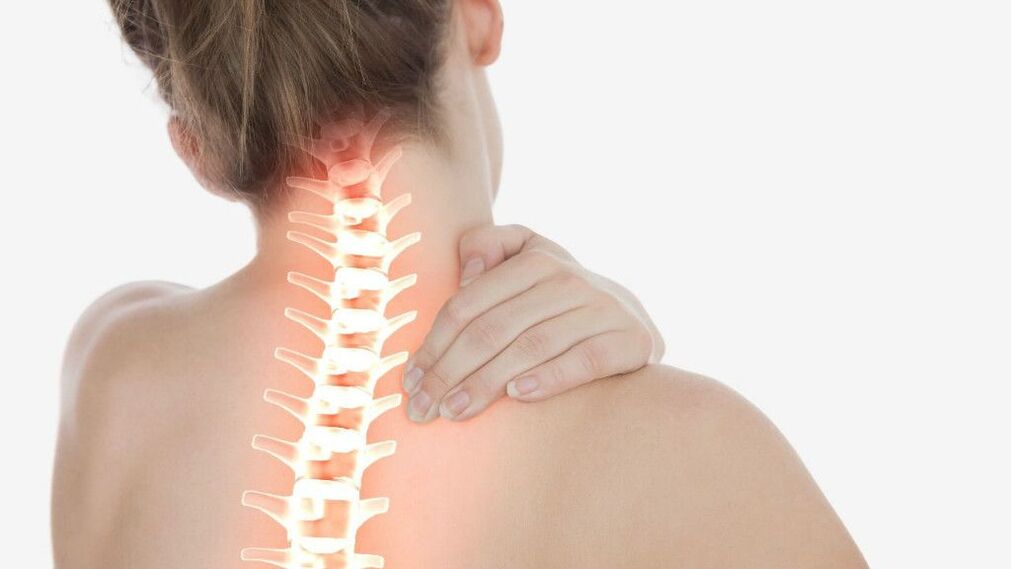The cervical spine osteochondrosis is a degenerative and dystrophic disease that affects the cervical vertebrae.This pathology is the most common pathology of the spine.

The symptoms of the disease
The symptoms of the disease progress occur.This includes the following manifestations:
- Weakness
- Dizziness
- Headache
- Noise in the ear
- Changing visual function (decrease in severity, blinking in front of the eye)
- Increased sensitivity in hand
- The numbness of the hand
- Then a man can usually stop his hand
- Feeling of stiffness in the upper limb joints
- Crunch her neck
- A feeling of stiffness and pressure in the chest.
The causes of illness
The main causal factors for osteochondrosis of the cervical spine are as follows:
- The low mobility of the neck, which leads to the fact that the intervertebral dial loses fluid, also leads to loss of elasticity of the cartilage.
- Loaded inheritance that determines the spare of the intervertebral disc strength
- Microtraumatization of the cervix with sharp turns, head decision, etc.
- The condition of the cartilage on the vertebral plate is a negative effect of metabolic disorders.
Diagnosis
Diagnostic search for osteochondrosis of the cervical spine contains the following studies:
- X -Ray
- Computer tomography
- Nuclear magnetic resonance
- Electromiography.
Each of the above studies contains a certain diagnostic information.The first three allow you to directly identify the changes in the spine, a feature of osteochondrosis.The latest study allows you to diagnose complications of osteochondrosis, which consist of damage to nerves.
An X -try test is performed in various planes and the attractions are performed to more accurate details of characteristic changes.This study explores calcification in the spinal ligament device, changes in the height of intervertebral discs, deformation of the cervical region, etc.
Computer tomography and nuclear magnetic resonance allow you to obtain the most reliable information and are therefore recommended to use them in complex diagnostic cases.
Electromiography examines the conductivity of nervous fiber, which very often reduces osteochondrosis of the cervical spine.This is due to the fact that as the height of intervertebral discs, there are conditions for compression of nerve roots.Therefore, clinical symptoms such as increased sensitivity, paresis and paralysis appear.
Complication
Lack of timely treatment of osteocondrosis of the cervical spine can lead to the following complications:
- The paralysis and paresis of the upper limb on one or two sides
- The brain is ischemic stroke.
Treatment of the disease
The purpose of treating osteochondrosis is as follows:
- To reduce the severity of the pain syndrome
- Preventing the progression of pathological changes.
The following methods are used to achieve these goals:
- Manual therapy is performed
- Acupuncture
- Medical physical education
- Gymnastics
- Swimming.
The goal is visible in parallel:
- Chondroproprotectors that increase cartilage resistance and allow for recovery
- Non -steroid anti -inflammatory drugs that reduce the severity of pain.
Unique treatment methods
- Kinesiology
This is a method for diagnosing and treating the spine, joints and nervous system based on muscle examination.The doctor examines the condition of the tissues and organs with the help of hands.
- Leeches
Together with leek bite, about 100 biologically active components come into human blood.This promotes purification of blood vessels, eliminates blood clots and disturbs formation.
- Reflexology
Acupuncture promotes cure osteochondrosis, radiculitis and other diseases of the spine and joints.The procedures relieve pain, heal the body and strengthen immunity.
Risk group
In the risk group, the categories of the following people should include:
- Loaded inherit
- Moving
- They have background processes.
Prevention
Preventive measures to prevent osteochondrosis of the spine are as follows:
- Correct posture during sitting
- The loads and relaxation alternation
- Exclusion of weights (in this case it is better to prefer a backpack)
- Regular underlying medical examinations for a neurologist and orthopedic for early detection of osteochondrosis of the cervix.
Diet and lifestyle
In the case of osteochondrosis, certain adjustments to the lifestyle should be made.These are the following:
- Treatment of the background process that led to osteochondrosis when it has been shown
- To exception of weighting
- Nutrition Normalization - Fat, Baked, Acute, Salt Rejection, Increase Vegetable Fiber and Products with Condroitin (Gel, Gel) in Diet
- The pace of physical activity is sufficient.



















